How to Correctly Use A Box Grater
Of all the gizmos and gadgets for the kitchen, have you noticed that there is just a mind-boggling array of devices that promise to help you with grating and shredding? Typically though, most people just stick with a basic box grater. It doesn't require any special knowledge or need for electricity. It is pure simplicity, but you do need to be careful about nicking your knuckles or finger tips.
One of the best things about a box grater is that it allows the shredded ingredients to gather underneath it. It's easier than hovering a hand-held grater over a bowl to catch the food.
What's interesting about the popular preference for the non-electric, non-fussy box grater usage is that most people commonly only use one side of their box grater. Are you in the one-sided club? I was, until I read up on what the other three sides are meant to do. Besides grating, it slices, it dices, and it yields different sizes of shreddings.
Let's look at each individual side: One of the wide faces of the box grater, the side usually shown in photographs (including mine), is going to be a shredder. Standard size is a quarter inch hole. This side is great for coarse shreds. Perfect for vegetables and what most people picture when they think of shredded cheese.
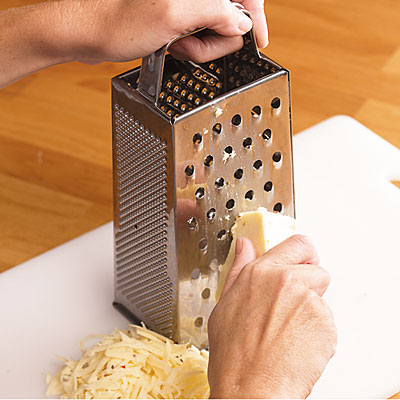
Then there's the slicer. It's found on one of the short sides of the box. A slot roughly two inches long and a quarter inch tall, this feature is perfect for making potato or zucchini chips.
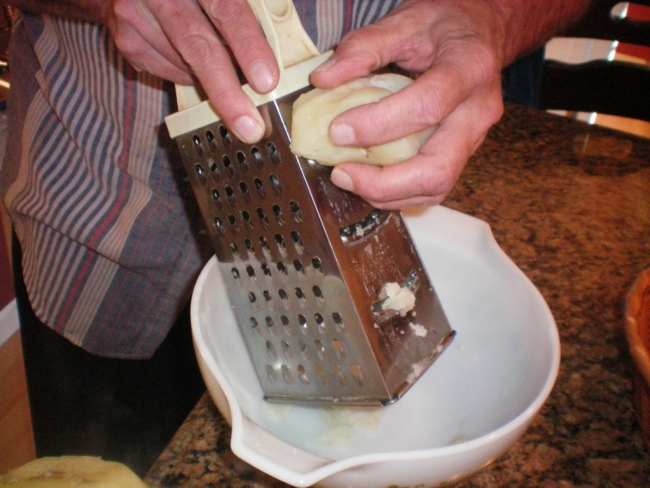
On the other wide face of the box grater you'll find the small-hole shredder. Its holes are half the size of the other wide side, approximately 1/8th inch. This side is designed to deliver a finer shred. "Taco" cheese is usually made using this side. And I recently read that you'll get a better zucchini bread or carrot muffin if this finer side is used for shredding. The finer shred creates a lighter and more moist product.
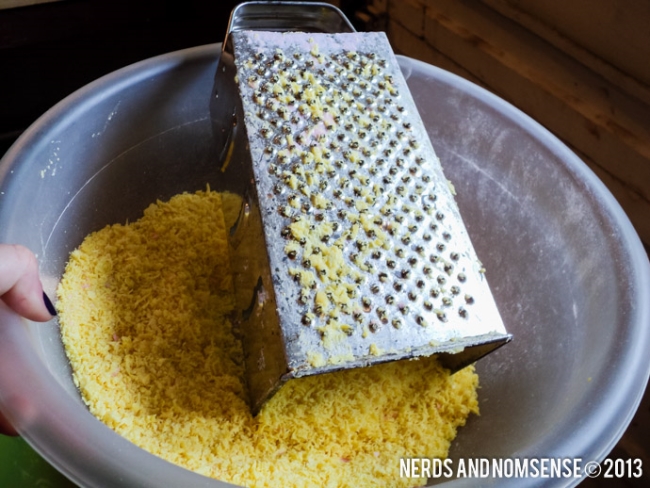
On the final side, the other narrow side, is the grater. Grating is a lot like shredding, but the end product is much smaller. Shredding will usually produce little strips about half an inch to an inch in length. Grating produces tiny nuggets. The consistency is similar in size to saw-dust. The Parmesan cheese that you buy in the plastic jar is a good example of something that was grated. Grating works best on hard foods, particularly hard cheeses such as Parmesan. I also use this side on my frozen lemons and limes.
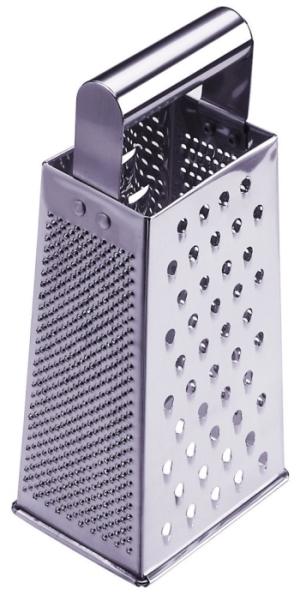
Unlike my Aunt Annie's day, we now have a lot of choices in the box grater department. For instance:
With the KitchenAid Box Grater Grate, you can easily grate and store with this awesome bonus addition. The grater overall does a good job of slicing and grating most vegetables and cheeses with the stainless steel blades. Both the grater and the storage container are dishwasher safe. I found this on target.com for about $20.
The Trudeau 4 Sided Grater has an innovative nonstick and rust proof design. It is commercial strength which makes it long lasting and sturdy. Reviewers say this is one grater that you won't regret buying. Amazon.com has it for $13.
Reviewers also really like the performance and grating power of this durable box grater. The Microedge Box Grater, with its tri-blade design, can grate anything you need without wearing out. The comfortable handle and bottom provide stability. This is another dependable, long lasting grater. And this was also on amazon.com—$8.80 was the price.
But what about the non-fancy, garden variety grater shown in the photos above? This happens to be the grater I have and it's been serving the purpose for over 30 years and cost a mere $3.99 back then. And now that I actually know how to correctly use a box grater, it'll serve its purpose even better! Fancy isn't really what we need in our kitchen tools&38212;what we need is to know how to correctly use our tools. Who knew the simple box grater was such an efficient and useful tool!
- www.fatgirlkitchen.typepad.com
- www.thenewartofbaking.blogspot.com
- www.nerdsandnomsense.com
- www.qwertycafe.com
- www.bestcovery.com
 Alice Osborne
Alice Osborne
Weekly Newsletter Contributor since 2006
Email the author! alice@dvo.com

 With the KitchenAid Box Grater Grate, you can easily grate and store with this awesome bonus addition. The grater overall does a good job of slicing and grating most vegetables and cheeses with the stainless steel blades. Both the grater and the storage container are dishwasher safe. I found this on target.com for about $20.
With the KitchenAid Box Grater Grate, you can easily grate and store with this awesome bonus addition. The grater overall does a good job of slicing and grating most vegetables and cheeses with the stainless steel blades. Both the grater and the storage container are dishwasher safe. I found this on target.com for about $20.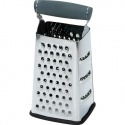 The Trudeau 4 Sided Grater has an innovative nonstick and rust proof design. It is commercial strength which makes it long lasting and sturdy. Reviewers say this is one grater that you won't regret buying. Amazon.com has it for $13.
The Trudeau 4 Sided Grater has an innovative nonstick and rust proof design. It is commercial strength which makes it long lasting and sturdy. Reviewers say this is one grater that you won't regret buying. Amazon.com has it for $13.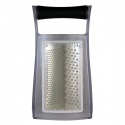 Reviewers also really like the performance and grating power of this durable box grater. The Microedge Box Grater, with its tri-blade design, can grate anything you need without wearing out. The comfortable handle and bottom provide stability. This is another dependable, long lasting grater. And this was also on amazon.com—$8.80 was the price.
Reviewers also really like the performance and grating power of this durable box grater. The Microedge Box Grater, with its tri-blade design, can grate anything you need without wearing out. The comfortable handle and bottom provide stability. This is another dependable, long lasting grater. And this was also on amazon.com—$8.80 was the price.